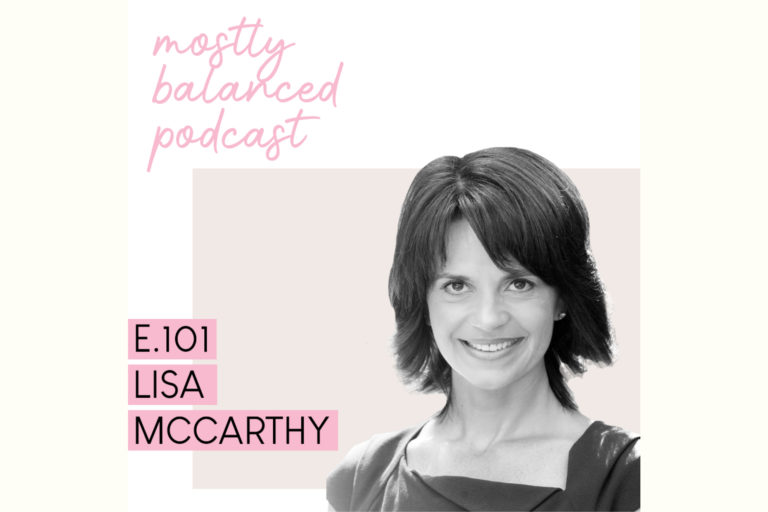
Samantha Saperstein was at a crossroads at JPMorgan Chase & Co. The then-CMO of commercial banking loved her work, but was facing extra childcare needs and needed more job flexibility. While attending a training program, Saperstein wrote a “bold vision” for success one year out: she had a meaningful role with more control and was handling her family needs. She vulnerably shared this vision with a senior executive.
“Kristin (Lemkau) knew that the firm was creating a new program with a full-time team dedicated to women, and would have to hire someone to run it,” Saperstein reflects. “She listened closely to me, and flagged the opportunity. I ended up helping them craft the strategy and then got to run it – It was great timing.”

Today, Saperstein is Managing Director and Head of JPMC’s “Women on the Move” initiative, whose mission is to empower employees professionally and personally, support small b
usiness owners and increase women’s financial health and literacy. As one of the largest talent development efforts at JPMC, Saperstein’s team has rallied nearly 7,000 colleagues to create their bold visions, generating excitement among partner organizations too. JPMC’s business banking division loaned more than $12 billion to female owners of small businesses the past three years, surpassing targets.
We’ve worked with over 100,000 people over the past nine years at Fast Forward Group, helping them to “Swing Big” like Saperstein did, and re-evaluate what matters most in their careers and lives. By giving people time to think and go deep into their professional and personal ambitions, they get energized about the future. They connect with their colleagues in a way that is rare in a world still reeling from pandemic and disruption. Companies that realize the importance of helping their people to “Swing Big” and shape their own future, will reap the rewards.
What Does Swinging Big Look Like?
Swinging Big is about going for things that are important to you even if there is a possibility you might fail, or you aren’t sure of the full path to make them happen. It’s about “throwing your hat over the wall,” a concept that traces back to a story by Irish writer Frank O’Connor about his travels with friends across the countryside. When they came to an orchard wall that seemed too high to pass, they took off their hats and threw them over the wall, forcing them to devise a way to get them. The lesson for present-day executives: Commit to something that is worth playing for, even if you don’t know how to do it, even if you might fail.
Here are four steps to creating a “Swing Big” culture where people take risks and thrive in 2022.
Stop Being Held Back By Limiting Beliefs
When you were young, you had an abundance of optimism and confidence – you felt you could be and do anything. But as we get older, we collect evidence about our limitations. When faced with a perceived risk, the soundtrack of “limiting beliefs” can set in:
- “I’m not smart enough;”
- “Launching a business is too hard;”
- “I am too old to reinvent myself”
These beliefs keep us playing small. Instead, ask yourself: What is this belief costing me? What would be possible if I let the belief go? Envisioning a compelling new future is the first step.
Get Comfortable Being Uncomfortable
By nature, humans are risk-averse. Nobel Prize-winning psychologist Daniel Kahneman found that people generally will pass up the chance to achieve gains to minimize the probability of losses.
Despite all this compelling science, we also know, intrinsically, that setting bold aspirations can inspire and motivate people. As Kahneman observed: “Merely reminding people of a time when they had power increases their apparent trust in their own intuition.” This is why we advise people to get comfortable being uncomfortable when it comes to setting goals and swinging big.
Over the years, people in our sessions have whispered, “But what if I fail?” We say, “So what? You’ll achieve so much more than you would have if you hadn’t swung big, and you’ll feel pride in what you did accomplish.” We coach people to expect some failure when they write their bold visions, but the benefit is making progress they wouldn’t have – and the pride that comes from going for it.
Create a Team Vision For Success With Common Language and Goals
Leaders who are willing to be vulnerable and do this exercise with their teams can build deeper trust and connection. When Tara Walpert Levy took the new role of vice president of agency and brand solutions at Google, she asked a lot of questions to learn why things were the way they were, which made some people feel anxious and challenged. Walpert Levy saw an opportunity to unify the team around a common vision, and to help them take more ownership of their future. The team, whose members crossed sales, operations, creative, measurement, strategy, deals and industry relations, participated in an off-site where Bold Visions gave them a common language and built trust around risk-taking and professional and personal growth.
“The team is now known for an incredible, high-performance culture, one where the visions are ambitious, the operational rigor is strong and [we’re] taking care of one another”
Walpert Levy vulnerably shares her vision every January and extends it to new hires. She knows it has been key to “pretty killer” results for a team that has tripled in size and quadrupled revenue under her watch. “The revenue growth has been extraordinary. We’ve launched many new businesses and services and our partner relationships have never been stronger … It’s changed the culture of the team,” she notes. Walpert Levy has since been promoted to vice president of the Americas for YouTube, leading business operations for the region.
Commit to Goals Even If You Don’t Know How To Get There

One way to help people declare bold aspirations is by writing them down as if they have
already happened. We encourage participants to fast forward one year from today and ask themselves: “What would extraordinary success look like?” Once people are freed from needing to know how, they can think big and dream in color about the what and the why.
The more vivid, specific, and clear your goal is, the more you and others will believe that it is possible. In research by Dr. Gail Matthews at Dominican University, San Rafael, Calif., more than 70% of people who wrote down their goals and held check-ins with an accountability partner reported success, compared to 35% of those who did not write or share them.
For Saperstein, putting that vision on paper and sharing it with an advocate is paramount. “We see people going for jobs they wouldn’t have applied for, having candid discussions with managers and colleagues they might not have on projects, assignments and compensation,” she says. Post-pandemic, she notes, “the way people relate to risk has changed. People feel more free to lift their heads, think holistically and create the lives they want.”
Today, employees want to do meaningful work for managers who care about their growth, fulfillment, and well-being. While the pressure, pace and uncertainty will continue, making it a priority to build a Swing Big culture will connect, engage and inspire your people. Doing so can build a workplace where people are living their best lives – and doing their best work.
Wendy Leshgold is Founder and President, and Lisa McCarthy is Founder and CEO at Fast Forward Group, a training and coaching company built on a philosophy of giving people and teams a proven approach to think big, manage stress and achieve success and fulfillment in their whole lives.

